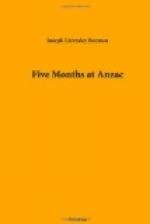PREPARING FOR THE ADVANCE
Towards the end of July great preparations were made for an offensive movement, the object being to take Hill 971 and so turn the Turk’s right. Large platforms were dug out of the hillsides in Monash Gully, each capable of holding three to five hundred men; they were constructed well below the sky line, and were fairly secure from shell fire. On these the incoming battalions were placed. There was not much room for sleep, but the main object seemed to be to have as many men handy as possible. The Turks seemed to be aware of the influx of troops, as they shelled the whole position almost all night. The beach, of course, was attended to most fervently, but considering the numbers of men landing few casualties occurred.
A 4.7 naval gun, which, I understand, had served in the relief of Ladysmith, was swathed in bags and landed on a barge, which conveyed it to a position alongside the pier. A party was put on to make a shield on the pier of boxes of our faithful friends the “forty-niners,” in case there were any Turks of an enquiring turn of mind along the beach towards Suvla.
The Engineers then constructed a landing place, and the gun was hauled ashore, again covered up, and conveyed to its position on our right during the night. General Birdwood outwitted the Turks that time, as they did not fire a shot during the whole operation.
On the third of August we received orders to remove to the left flank, the right being held by the Australian Division which participated in the operation known afterwards as Lone Pine. The last day on the beach proved to be pretty hot with shelling, chiefly from Beachy Bill. A number of pinnaces were busy all day towing in barges from the transports, and this could be easily seen from the olive grove where Bill had his lair. At one time the shells came over like rain; two of the pinnaces were hit below the water-line, and were in imminent danger of sinking. Through all the shelling Commander Cater ran along the pier to give some direction regarding the pinnaces, but was killed before he got there. He was a brave man, and always very courteous and considerate.
Our casualties during this afternoon were pretty considerable, and our stretcher-bearers were constantly on the “go” getting men under shelter.
Early in the morning the Ghurkas came ashore, but the Turks spotted them, and gave them a cordial welcome to Anzac. They are a small-sized set of men, very dark (almost black), with Mongol type of face and very stolid. One was killed while landing. They were evidently not accustomed to shell-fire, and at first were rather scared, but were soon reassured when we told them where to stand in safety. Each carried in addition to his rifle a Kukri—a heavy, sharp knife, shaped something like a reaping-hook, though with a curve not quite so pronounced. It was carried in a leather case, and was as keen as a razor. I believe the Ghurkas’ particular delight is to use it in lopping off arms at the shoulder-joint. As events turned out we were to see a good deal of these little chaps, and to appreciate their fighting qualities.




